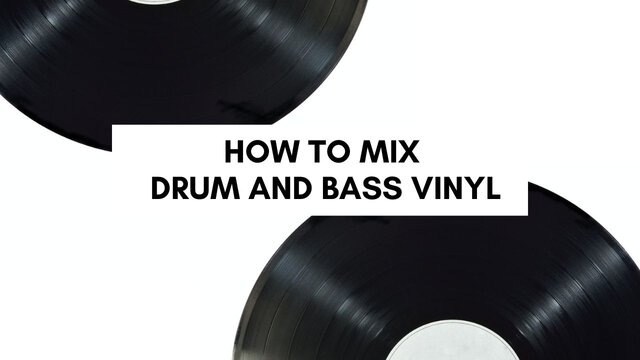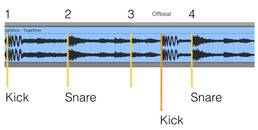
Mixing drum and bass vinyl is a unique experience that requires a good understanding of the genre’s rhythmic beat structures. It’s a very different experience to DJing on CDJs or a DJ Controller as there’s plenty of extra help visually on the DJ software or digital displays.
The key to mixing Drum and Bass vinyl is beat matching by ear, knowledge of song structure and beat structures. Let’s dive right in!
Understanding Drum and Bass Rhythm
Drum and Bass rhythm is not consistent, unlike a 4×4 beat pattern in House music, Drum and Bass presents all kinds of variations of drum patterns in relation to the kick and snare.
The usual BPM (Beats Per Minute) of 174, is the typical speed in which this music type is played.
The most common beats in the Drum and Bass drum pattern are the 1st and 2nd beats. Which are Kick and Snare. Where there’s variation is after beat 2, meaning around beats 3 and 4 the drum pattern can change quite a lot and varies from track to track.
Here’s what the most common drum pattern look like in D&B music. If you’re starting out mixing and DJing Drum & Bass, try starting mixing two tracks with this beat pattern to start off with.

Related article: How to DJ Drum and Bass
Cueing up in headphones
You have a turntable on the left and right. The left turntable is connected to channel 1 on the mixer and the right on channel 2.
Press play on the turntable for channel 1 (Left). On channel 2, press CUE button so that you can hear the music playing in your headphones.
The purpose of listening to the music in your headphones of one track, whilst the other is playing, is to enable you to hear if the two beats are in sync with one another.
This means that you’ve correctly adjusted the pitch shifter (tempo) to align the beats.
Preparing Your Records: Marking Cue Points
To be super prepared, you can listen to the intros of your record vinyls and mark on the label of the record vinyl where you want to start cueing up the track.
You can put a small circle sticker on the inside of the vinyl, inline with the needle, then you know you’ve got the right starting point (cue point). Put more than one on the vinyl if you’d like to to start further down the introduction of the music.
What to listen out for
Beat matching by ear is all about listening for changes in rhythm, melody and sounds. Usually these new changes to the sound highlight where to cue up a record vinyl.
Also the same technique can be used for cueing up a track (channel 2 for example), followed by knowing where to let go of the record vinyl to start beat matching.
There’s a technique in DJing called phrase matching, check out the below article for more info.
Related article: Phrase Matching Drum & Bass
Pitch riding to beat match
As mentioned earlier, 174 BPM is the typical tempo of Drum and Bass, but sometimes can be slightly faster or slower. I find older music can vary more so than modern day music releases in Drum and Bass.
A quick tip is to start with checking if the tempo number exists on the label of the record vinyl itself. If both 174 BPM then great. Set both of the tempo shifters to exactly the same point e.g. neutral.
If they’re not the same tempo, then you need to do some work. Set the tempo of the new track that you’re looking to beat match slower than the existing track playing through the speakers.
Cue up in the headphones, release the record vinyl, then move the tempo shifter to be faster (this means moving the shifter down towards you). You’ll start to hear the beats becoming more aligned and in sync.
Making adjustment for perfect beat matching
Make adjustments to the record turntables platter or use the tempo shifter by quickly jolting it slower or faster to quickly align the beats again.
Once you’ve got the two beats aligned and aren’t falling out of sync with one another. Then the next step is to start blending the two tracks together. It’s time to learn some tips for blending two tracks together.
Mixing Drum and Bass using EQ & Faders (Crossfader)
Using the EQ is really important for smoother transitions. Bass heavy music especially benefits from DJs cutting out the LOW end EQ. Doing this helps for only one tracks bass to kick through in the mix.
Counter-acting both EQs in the low end, or mid, is a good method to keeping the EQ balanced in the mix.
Some mixers do have LPF and HPF which also achieve a similar control of EQ but all in one control knob.
At a point in which you’re satisfied to blend over to the next track, use the crossfader (or channel fader) to let the new track shine through.
There are other techniques to mix Drum & Bass such as Double Drops, check this Double Drop Technique here.
Common Mistakes and How to Avoid Them
If in doubt, take it out
Vinyl DJing does take some tweaking of the tempo, and sometimes you’ll find you’re in the mix but the beats start going out of sync. So “If in doubt, take it out” of the mix. Re-align the tempos and start the mix again from scratch.
There’s nothing worse the trying to save two beats clashing. It sounds like a train wreck and not worth your listeners recognising how novice you are.
Always put your records back into their vinyl sleeve
There’s some rather annoying about a record vinyl needle skipping ahead and jumping about. This is usually because the vinyl is damaged from poor safe keeping. Making sure you keep your vinyls in a vinyl sleeve will certainly contribute to long term use.
Try not have your vinyls in a hot place or in the sun. Warped vinyls does occurs and can be very annoying. More info on warped vinyls here.
